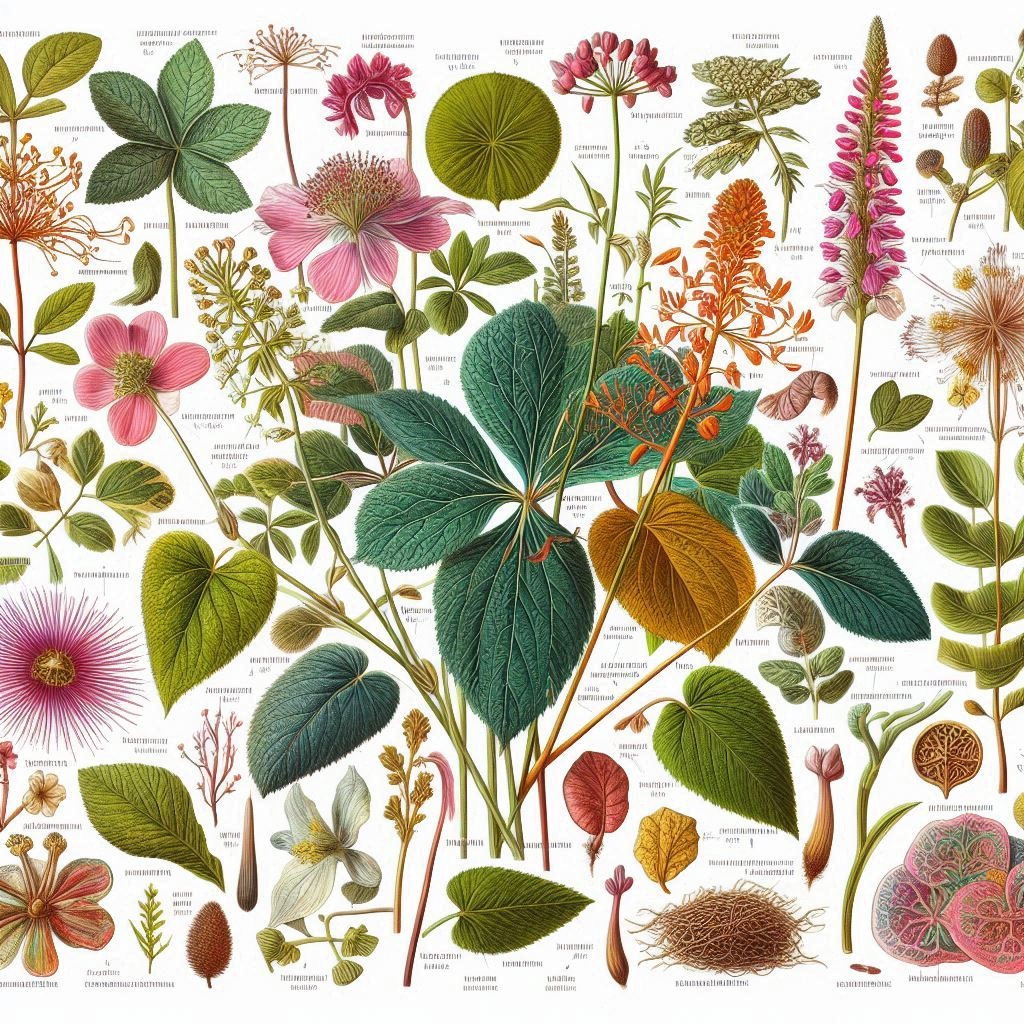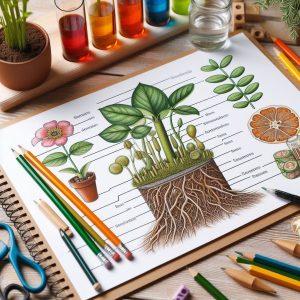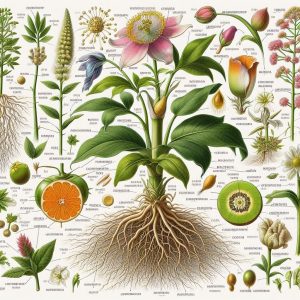Importance of Plant Morphology
Plant morphology plays a vital role in plant identification and classification, helping botanists distinguish between different species. It also aids in understanding plant functions and adaptations to their environments, which is essential for agriculture, horticulture, and conservation. By studying plant morphology, scientists can develop strategies for breeding better crops and preserving biodiversity.

Ancient Beginnings
The study of plant morphology dates back to ancient civilizations. Early botanical knowledge was often documented in medicinal texts and agricultural treatises. For instance, Theophrastus, a Greek philosopher known as the “Father of Botany,” wrote extensively about plant forms and functions in his works “Enquiry into Plants” and “On the Causes of Plants” around 300 BCE. His observations laid the groundwork for future botanical studies.
Medieval and Renaissance Contributions
During the Medieval period, botanical knowledge was preserved and expanded in herbals, which were manuscripts detailing the medicinal uses of plants. The Renaissance brought a renewed interest in natural sciences, leading to more systematic studies of plant forms. Botanists like Andrea Cesalpino and Joachim Jungius made significant contributions to plant morphology. Cesalpino’s work, “De Plantis,” published in 1583, was one of the first attempts to classify plants based on their morphology.
The Age of Enlightenment
The 17th and 18th centuries marked a period of rapid advancement in plant morphology. Carl Linnaeus, a Swedish botanist, developed the binomial nomenclature system, which classified plants based on their reproductive structures. His work “Species Plantarum,” published in 1753, is a cornerstone of modern taxonomy. At the same time, Marcello Malpighi and Nehemiah Grew pioneered the microscopic study of plant tissues, revealing the cellular structure of plants for the first time.
19th Century: The Rise of Structural Botany
The 19th century saw the rise of structural botany, with extensive studies on plant anatomy and morphology. Wilhelm Hofmeister’s discoveries about the alternation of generations in plants and their embryological development were groundbreaking. Anton de Bary’s work on plant pathology and the life cycles of fungi further advanced the field. The period also saw the establishment of botanical gardens and herbaria, which became centers for plant research and education.
20th Century: Integrating Genetics and Physiology
The 20th century brought a deeper understanding of plant morphology through the integration of genetics and physiology. The discovery of the structure of DNA by James Watson and Francis Crick in 1953 revolutionized biology, including plant sciences. Researchers began to link morphological traits with genetic information, leading to advances in plant breeding and biotechnology. The development of electron microscopy provided detailed images of plant cells and tissues, further enhancing our understanding of plant structure.
Modern Advances and Future Directions
Today, plant morphology is a highly interdisciplinary field, incorporating insights from genetics, molecular biology, and computational science. Advanced imaging techniques, such as confocal microscopy and 3D modeling, allow scientists to study plant structures in unprecedented detail. Modern plant morphologists are also exploring the role of epigenetics and environmental factors in shaping plant form. The future of plant morphology promises exciting discoveries that will continue to expand our understanding of plant biology.
Table: Milestones in the History of Plant Morphology
| Time Period | Milestone | Key Figures |
|---|---|---|
| Ancient Times | Documentation of plant forms and uses | Theophrastus |
| Medieval Period | Preservation of botanical knowledge in herbals | Various |
| Renaissance | Systematic studies and classification of plants | Andrea Cesalpino, Joachim Jungius |
| 17th-18th Century | Development of binomial nomenclature and microscopic studies | Carl Linnaeus, Marcello Malpighi, Nehemiah Grew |
| 19th Century | Advances in structural botany and plant anatomy | Wilhelm Hofmeister, Anton de Bary |
| 20th Century | Integration of genetics and physiology | James Watson, Francis Crick |
| 21st Century | Interdisciplinary approaches and advanced imaging | Various |

Key Components of Plant Morphology
The study of plant morphology involves several key components:
- Roots: The underground part of the plant that absorbs water and nutrients. Roots also anchor the plant in the soil. Learn more about root morphology.
- Stems: The above-ground structures that support leaves and flowers, and transport water and nutrients. Explore the structure and function of plant stems.
- Leaves: The primary sites of photosynthesis in most plants, with various shapes and arrangements. Discover the diversity of leaf morphology.
- Flowers: The reproductive structures of angiosperms, which vary widely in form and function. Investigate flower morphology.
- Fruits and Seeds: The structures that develop from flowers after fertilization, aiding in the dispersal of offspring. Read about fruit and seed morphology.
Table: Major Plant Parts and Their Functions
| Plant Part | Function | Examples |
|---|---|---|
| Roots | Absorption of water and nutrients; anchorage | Taproots, fibrous roots |
| Stems | Support; transport of water and nutrients | Herbaceous stems, woody stems |
| Leaves | Photosynthesis; gas exchange | Simple leaves, compound leaves |
| Flowers | Reproduction | Complete flowers, incomplete flowers |
| Fruits and Seeds | Dispersal of offspring | Berries, nuts |
Applications of Plant Morphology
Understanding plant morphology has several practical applications:
- Agriculture: Helps in the breeding of crop varieties with desirable traits. See how plant morphology aids crop improvement.
- Ecology: Assists in studying plant-environment interactions. Learn about plant morphology in ecological research.
- Horticulture: Enhances the cultivation and maintenance of ornamental plants. Explore horticultural applications.
1. Agricultural Improvement
In agriculture, plant morphology is used to enhance crop yields and quality. By studying plant structures, agronomists can develop crops with better resistance to pests, diseases, and environmental stress. Techniques such as selective breeding and genetic modification rely heavily on morphological insights to create varieties that meet specific agricultural needs. For instance, understanding root systems can lead to crops with better drought resistance.
2. Horticulture and Landscaping
In horticulture, plant morphology guides the cultivation of ornamental plants and landscape design. Knowledge of plant growth habits, flower structures, and leaf shapes helps horticulturists select appropriate plants for different environments and aesthetic purposes. This information is crucial for designing gardens, parks, and green spaces that are both functional and visually appealing.
3. Environmental Conservation
Plant morphology plays a significant role in environmental conservation and restoration projects. Understanding plant forms and structures helps ecologists restore degraded habitats and manage natural resources effectively. For example, studying the morphology of native plants allows scientists to select species that can thrive in specific conditions, contributing to successful reforestation and habitat restoration efforts.
4. Medicinal Plant Research
The study of plant morphology is essential in identifying and utilizing medicinal plants. Morphological characteristics such as leaf shape, flower structure, and stem type can help researchers identify plants with therapeutic properties. Traditional medicine and modern pharmacognosy both benefit from understanding plant morphology to discover new drugs and treatments derived from plants.
5. Biotechnology and Genetic Engineering
In biotechnology, plant morphology provides insights into genetic engineering and biotechnological applications. By understanding how plant structures relate to their functions, scientists can manipulate plant genes to produce desired traits. This includes developing genetically modified plants with enhanced nutritional content, resistance to pests, or improved growth rates.
6. Education and Research
Plant morphology is a foundational aspect of botanical education and research. It provides essential knowledge for students and researchers in botany and related fields. Detailed studies of plant structures help in understanding fundamental biological processes, evolutionary relationships, and ecological interactions.
Table: Applications of Plant Morphology
| Application Area | Description | Benefits |
|---|---|---|
| Agricultural Improvement | Enhancing crop yields and quality through morphological insights. | Better resistance to pests, diseases, and environmental stress. |
| Horticulture and Landscaping | Guiding the cultivation and design of ornamental plants. | Functional and aesthetically pleasing gardens and green spaces. |
| Environmental Conservation | Restoring habitats and managing natural resources. | Successful reforestation and habitat restoration efforts. |
| Medicinal Plant Research | Identifying and utilizing plants with therapeutic properties. | Discovery of new drugs and treatments. |
| Biotechnology and Genetic Engineering | Developing genetically modified plants with desirable traits. | Enhanced nutritional content, pest resistance, and growth rates. |
| Education and Research | Providing foundational knowledge for students and researchers. | Understanding fundamental biological processes and evolutionary relationships. |
Future Directions in Plant Morphology
The future of plant morphology is promising, with advancements in imaging technologies and computational biology. Researchers are now able to create 3D models of plant structures and analyze them in unprecedented detail. This integrated approach will enhance our understanding of plant development, adaptation, and evolution. Read more about future trends in plant morph

Detailed Plant Structure
Conclusion
The history of plant morphology is a testament to humanity’s enduring curiosity about the natural world. From ancient herbalists to modern molecular biologists, the study of plant form and structure has continuously evolved, driven by new discoveries and technological advances. As we move forward, plant morphology will remain a crucial field, providing insights that are vital for agriculture, ecology, and our understanding of life itself. Plant Morphology is a critical area of study within botany, providing essential insights into the structure and function of plants. It supports a wide range of scientific and practical applications, from agriculture to environmental science. As technology continues to advance, our understanding of plant morphology will deepen, leading to new discoveries and innovations.
For further reading, visit these resources:
1. What is plant morphology?
Plant morphology is the scientific study of the physical form and external structure of plants. This includes the analysis of various plant parts such as leaves, stems, roots, flowers, and fruits. The field explores how these structures develop, their functions, and how they contribute to the plant’s survival and reproduction.
2. Why is plant morphology important?
Understanding plant morphology is vital for several reasons. It aids in identifying plant species, understanding plant development, and improving crop breeds. Knowledge of plant structures helps in agriculture to enhance plant growth, resistance to diseases, and adaptation to environmental changes. It also supports biodiversity conservation and ecosystem management.
3. How does plant morphology impact agriculture?
In agriculture, plant morphology is used to optimize plant traits for better yields and resistance to pests and diseases. For example, studying leaf shape and root structure can lead to the development of crops that are more efficient in nutrient uptake or more resistant to drought. This helps farmers achieve higher productivity and sustainability in farming practices.
4. Can plant morphology help with environmental conservation?
Yes, plant morphology is crucial for environmental conservation efforts. By understanding the morphological characteristics of plants, conservationists can select appropriate species for reforestation projects, design effective restoration strategies, and preserve native plant species. This knowledge helps maintain healthy ecosystems and biodiversity.
5. How is plant morphology used in medicinal research?
Plant morphology plays a significant role in medicinal research by helping researchers identify plants with potential therapeutic properties. Understanding the physical characteristics of plants can lead to the discovery of new drugs and treatments. For example, the study of plant anatomy and chemistry can reveal the presence of bioactive compounds used in pharmaceuticals.
dispersal mechanisms, and evolutionary adaptations. Different fruit types and structures offer insights into the reproductive strategies and ecological interactions of plants.
13. What tools and techniques are used in plant morphology?
Plant morphology utilizes various tools and techniques, including microscopy, imaging, morphometrics, and computer modeling. These methods help in detailed analysis and visualization of plant structures and forms.
14. How does plant morphology relate to plant taxonomy?
Plant morphology is fundamental to plant taxonomy, which involves the classification and naming of plants. Morphological characteristics are used to identify and categorize plant species, understand their relationships, and develop identification keys.
15. What are some current research trends in plant morphology?
Current research trends in plant morphology include the study of developmental genetics, evolutionary morphology, ecological adaptations, and the impact of environmental changes on plant form and function. Advances in technology and interdisciplinary approaches are driving new discoveries in this field.
Disclaimers
The content provided here is intended for educational purposes and general information about plant morphology. While every effort is made to ensure the accuracy of the information, it should not be considered as a substitute for professional advice or consultation. Always seek expert guidance for specific applications, research, or practices in plant morphology.
Cautions
1. Field Identification: Accurate plant identification is crucial. Misidentification can lead to incorrect conclusions or ineffective conservation strategies. Use reliable field guides and consult experts when necessary.
2. Ethical Considerations: When conducting research or collecting plant samples, adhere to ethical guidelines and local regulations. Avoid harming plant populations or ecosystems, and obtain necessary permits for research and collection.
3. Application in Biotechnology: When applying plant morphology knowledge to biotechnology, such as genetic modification, consider potential ecological and environmental impacts. Ensure that biotechnological interventions are safe, thoroughly tested, and beneficial to the environment and society.
4. Impact of Climate Change: Be aware of the effects of climate change on plant morphology. Changes in temperature, precipitation, and other environmental factors can alter plant structures and growth patterns, which may affect agricultural practices and conservation strategies.
5. Integration with Other Disciplines: Plant morphology should be integrated with other scientific disciplines such as plant physiology, ecology, and genetics for a comprehensive understanding of plant function and development. This interdisciplinary approach enhances the effectiveness of research and application.
I hope this article is beneficial for your study.


